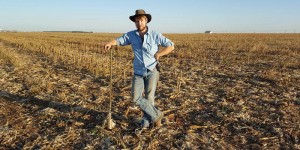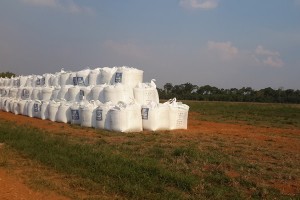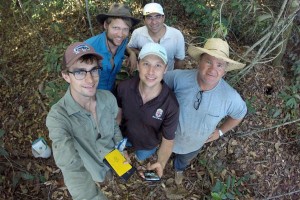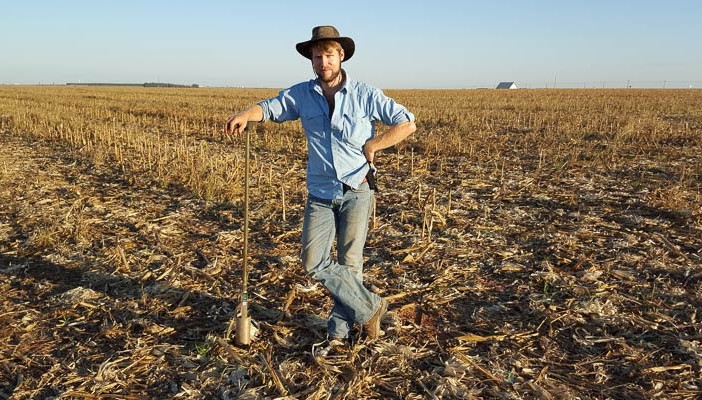The University of Vermont
By Joshua E. Brown

From the Amazon to Africa, tropical regions are widely expected to play a growing role in supplying food to the world. With global population on the rise, many policy experts and conservationists see agricultural intensification as a winning strategy to produce more food per acre while sparing tropical forests from being converted to farmland. Just pour on the fertilizer.
But a new study in Nature Plants raises a grave concern: if tropical countries try to meet rising global demand for food by turning to intensive farming techniques, it will require vast amounts of phosphorus fertilizer — which must be mined from phosphate rock, a limited natural resource.
“In some parts of the tropics, for every ton of phosphorus harvested in food, you have to donate one ton to the soil,” said Eric Roy, a scientist at the University of Vermont who led the new study. “We call that the phosphorus tax.”
This tax happens not only because phosphorus is naturally low in many tropical soils, but also because these soils tend to bind phosphorus fertilizer, making less of it available to crops than soils in many temperate regions of the world, like North America and Europe.
The first-of-its-kind study estimates that to intensify crop production on farms atop phosphorus-binding soils worldwide would require paying a phosphorus tax equal to as much as twenty-five percent of recent global phosphorus fertilizer consumption. These phosphorus-sucking soils could capture 1 to 4 million metric tons of fertilizer phosphorus each year, the research shows. This is roughly the same amount as is used in all of North America annually: about 2 million metric tons of P.

If tropical farming intensifies, there could be a staggering cost: millions of tons of phosphorus “tax” that must be paid to the soil, a new UVM-led analysis shows. The tax will require vast amounts of fertilizer—like the bags shown here in Mato Grosso, Brazil. (Photo: Peter D. Richards)
Double P by 2050
The researchers estimate that approximately ten percent of global cropland is this phosphorus-fixing soil type — and much of that is found in Brazil, other parts of South America, sub-Saharan Africa, and the rest of the tropics. If farmland in these tropical areas expands as expected, the “P-tax” — meaning phosphorus lost to the soil instead of harvested in crops — will rise steeply too.
The new study, supported in part by the National Science Foundation, shows that if the land-use scenarios of the Millennium Ecosystem Assessment were to actually unfold, the phosphorus tax imposed by these P-binding soils would double by 2050. “That’s similar to the amount of phosphorus fertilizer currently consumed in North America and Europe combined,” said Roy, an assistant professor in UVM’s Rubenstein School of Environment and Natural Resources.
In Brazil

A research team led by Eric Roy in a forest adjacent to a soybean farm in the Amazon biome, Mato Grosso, Brazil. From left to right in front row: Edwin Willig (Brown University undergraduate), Peter Richards (USAID, formerly a post doc at Brown University), Saul Steffanello (Mato Grosso farmer). From left to right in back row: Eric Roy, Felipe Ferraz Vazquez (State University of Mato Grosso, Brazil) (Photo: Peter D. Richards)
The analysis by Roy and his nine co-authors, including Stephen Porder, a scientist at Brown University, indicates that this tax on farmers in the tropics would continue for decades.
“Tropical soils are really different, and so the costs, consequences, and considerations of trying to do this (intensive agriculture) in the tropics are different,” Porder said. “Our study is the first to ask the question about any of these costs. What is it really going to take to do this at a large scale?”
The team interviewed 49 farmers in the Brazilian state of Mato Grosso — which produces eight percent of the world’s soybeans. The farmers noted that to maintain productivity they needed high levels of phosphorus each year, some even after three decades of intensive fertilizer use. “The farmers there say the soil is so hungry for phosphorus,” Roy said — these soils do not saturate with phosphorus the way soils in the U.S. Midwest and other global “breadbasket” regions do.
From these interviews, and other analysis in the new study, the scientists anticipate that farmers in many tropical areas will be obliged to apply high levels of inorganic fertilizers each year to maintain their crop yields. This means that their farms’ fates will be tied to the finite supply of phosphate rock, which is largely found in a handful of places in the world, including some mines in the United States and a large remaining supply in northern Africa. About 72 percent of current reserves are in Morocco and Western Sahara.
“In a lot of ways, it’s like fossil fuels,” Roy said. “There’s a limited stock of phosphate rock that we have to support society.”
Based on this research, Eric Roy is concerned about how sustainable farming in the tropics will be in the coming half-century. “This phosphorus tax needs to be part of the conversation, part of calculations about the economic and ecological realities of agricultural intensification in the tropics,” he said. “Our findings suggest that relying on high-input, intensive tropical agriculture to support global food supply carries long-term risks.”
Agricultural alternatives
Roy and Porder agreed that there are ways to reduce the risk and the phosphorus tax.
One way would be to recycle more phosphorus-rich livestock manure to tropical croplands and reduce the need for synthetic fertilizer made from phosphate rock. However, in Brazil this has been limited because most of the soybeans farmers grow are exported to feed animals reared for meat in China and Europe. Globally, however, this is an important solution. Roy noted that researchers around the world are developing ways to “close the loop” and safely recycle phosphorus from human waste back to croplands as well.
A second possibility would be to rethink high-meat diets, which require more land in agriculture — and more phosphorus — than a low-meat or meatless diet would. A lot of cropland is currently devoted to growing feed — including corn and soybeans — for meat animals. By growing more crops for people, rather than livestock, Roy said, less land and other resources would be needed for agriculture overall.
Third, a lot of the world’s food is wasted, Porder said. Reducing food waste would also slow the presumed need to intensify tropical agriculture.
A final option may be technology, if future scientists can develop a way to recover phosphorus from the soils that currently bind it tightly.
These changes are important to start now. “If we don’t make those changes to diets and we don’t make those changes to food waste, we will need more land in intensive production,” Stephen Porder said. That would incur other resource costs beyond phosphorus, he said, like using more pesticides and fossil fuels as well.
Eric Roy said he is not worried that the world is going to “run out” of phosphorus. Rather, food security could become more vulnerable to political conflict and the volatility of phosphate rock prices. “Unlike nitrogen, we can’t obtain it from the atmosphere,” Roy said. “Unlike oil, there is no substitute for phosphorus.”







